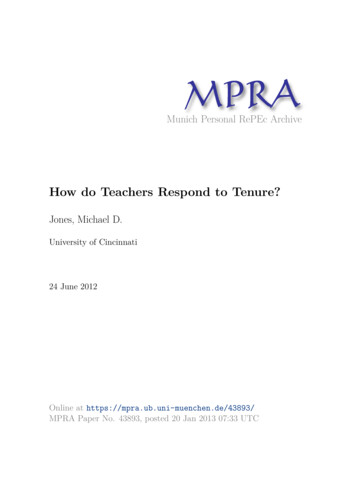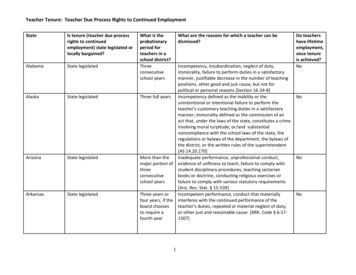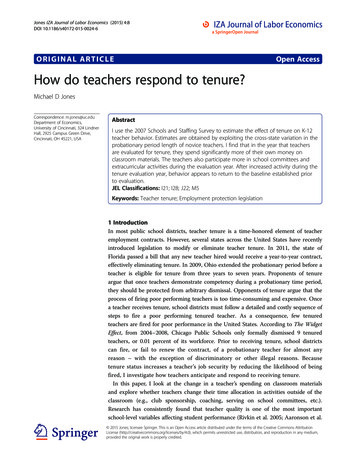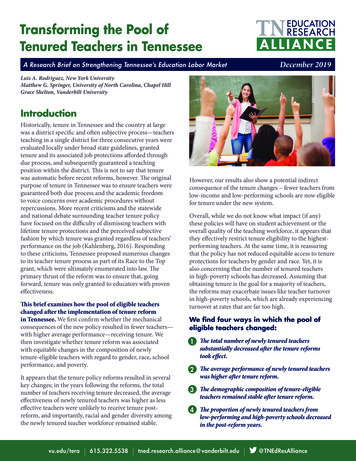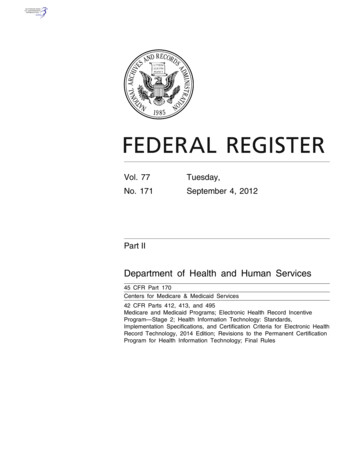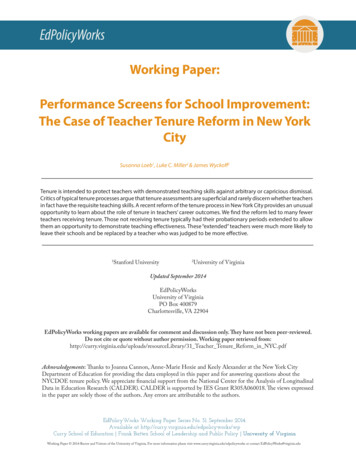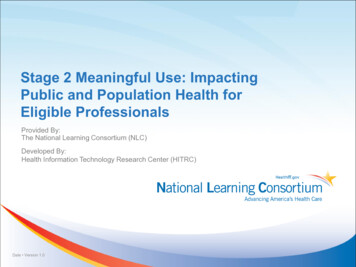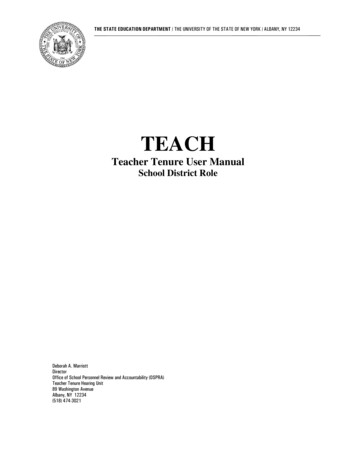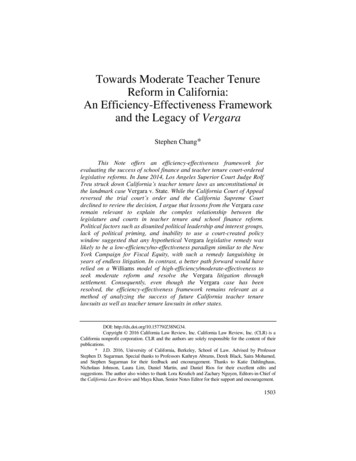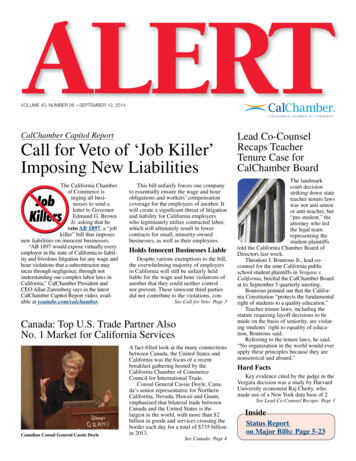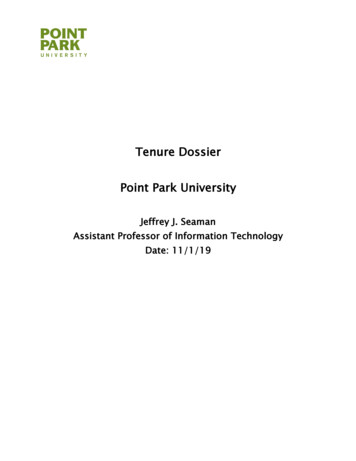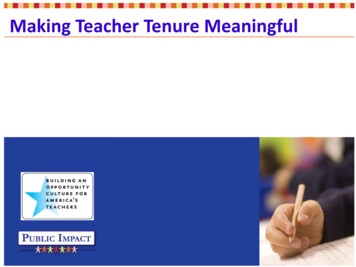
Transcription
Making Teacher Tenure Meaningful
Making Teacher Tenure MeaningfulAdapted from Teacher Tenure Reform:Applying Lessons from the Civil Service and Higher Education(Public Impact, 2011)**Please see the original paper for full citations. Select citations included here.**Public Impact Contributors:Emily Ayscue Hassel, Julie Kowal, Joe Ableidinger, and Bryan C. HasselPublic Impact is grateful tofor supporting the development and productionof both this slide deck and the underlying paper.September 2011www.opportunityculture.org2
OverviewWhy Does Tenure Reform Matter?Tenure Design ElementsTenure Reform: Two PathsMajor Design Options: Elite and Inclusive TenureSeptember 2011www.opportunityculture.org3
Why Does Tenure Reform Matter?Tenure affects teacher quality, which affects how muchchildren learn . . .Who GetsTenureSeptember tLearning4
Why Does Tenure Reform Matter?Tenure affects teacher quality Tenure can affect: Who enters teaching Who remains in teaching Who leaves teaching What teachers do at work, both before and after tenure.Teacher quality affects how much students learn Teachers have a bigger impact on student learning than anyother school-based factor.1 Top 20% teachers produce 3X the learning gains of bottom 20%.2 Students who consistently have top 20–25% teachers learnenough to close most achievement gaps within half a decade.3September 2011www.opportunityculture.org5
Design Elements of TenureTenure (or its equivalent) includes five core design elements:1. Time to tenure time on the job until a candidate is eligible for tenure2. Criteria to earn tenure evaluation categories difficulty of standards3. Process for conferring tenure levels of review presumption of tenure/nontenure who makes final decision4. Tenure protections rights to certain grounds, steps, and timing for dismissals5. Other career and reward opportunities number, timing, and nature of otherpromotion, pay, and recognition opportunities that act in concert with tenureSeptember 2011www.opportunityculture.org6
Design Elements: Time to TenureEmployees must serve a certain number of yearsbefore they are eligible to earn tenure.Typical Time to Tenure (years) 4Higher Education*Civil Service**K-12 Teaching***012345678* Average across four-year colleges; varies by institution.** Within most federal agencies.*** States range from one to five years (Ohio is seven); in 2010, 34 states had three-year probationary periods.September 2011www.opportunityculture.org7
Design Elements: Criteria to Earn TenureThe evaluation categories and difficulty of meeting standards toearn tenure differ significantly across higher education institutions,civil service, and K–12 public education.SettingDifficultyEvaluation Categories (examples)HigherEducationHigh(Varieswidely) The number, quality, and prestige of scholarly publications Presentations, workshops, and conferences Recognition including awards, fellowships, and external grants Successful teaching as measured by classroom observations, studentevaluations, syllabi, and contributions to new courses Service via committees, civic groups, or professional associationsCivilServiceLow Continued service during the probationary periodK–12EducationLow Continued service during the probationary period Evidence of student learning (in a small number of states)September 2011www.opportunityculture.org8
Design Elements: Process for Conferring TenureThe levels of review, who makes tenure decisions, and presumptionof tenure/non-tenure also differ significantly across sectors.SettingIntensityProcess (examples)HigherEducationExtensive;multifaceted Multiple reviewers including peers, supervisors, and school andinstitution leaders Reviews include scholarly work, evidence of performance, andcandidate statements Tenure denial is the default; candidates bear the burden ofproving their qualifications to reviewersCivilServiceMinimal;automatic Evaluations conducted but viewed as mere formalities Few dismissals during probationary period Granting tenure-like job protections is the defaultK–12EducationMinimal;automatic Evaluations not typically part of tenure-granting process Few dismissals during probationary period Granting tenure is the defaultSeptember 2011www.opportunityculture.org9
Design Elements: Tenure ProtectionsAcross sectors, the grounds and steps required for dismissalstogether form the level of job protection tenure provides.SettingLevel ofProtectionProtections (examples)Higher Education Very highCivil ServiceVery highK–12 EducationVery high Dismissal only for “just cause” or specified reasons Right to be represented by counsel Right to notice, hearing, written decision, and appealThe result: very few protected employees get dismissed each year.Percent dismissed for performance5Tenured professors0.01%Tenured K-12 teachers0.04%Federal employees0.5%State employees2%0%September 20111%2%3%4%www.opportunityculture.org5%6%7%8%10
Other Career and Reward OpportunitiesAcross sectors, tenure may be the only or one of manyperformance recognitions available to high performers.SettingOther Career and Reward OpportunitiesHigher EducationTenure is part of a dynamic array of performance-based rewardsand opportunities (e.g., compensation, promotion, chairedpositions)Civil ServiceHigh performers can receive promotions and raises; otheragencies provide opportunity for new responsibilities andchallengesK–12 EducationTeachers have few opportunities for performance-basedpromotion or pay advancement (beyond salary schedule), unlessthey leave instruction to become administratorsSeptember 2011www.opportunityculture.org11
Summary: The State of K–12 TenureDesign ElementState of K–12 Teacher Tenure Today, in Most StatesTime to TenureShort, before career-lasting performance level is demonstratedCriteria to EarnTenureFew criteria and easy or no standardsProcess forConferring TenureMinimal process, typically automaticTenureProtectionsVery high protectionsOther Career andRewardOpportunitiesFew opportunities for promotion or pay advancement inteaching rolesConclusion: Teacher tenure today does little to promote afocus on student learning, and much to undermine it.September 2011www.opportunityculture.org12
Tenure Reform—Two PathsChanging tenure to improve student learning requires policy andeducation leaders to follow one of two paths:Option 1: Redesign tenure Design to increase entry, retention, power, and pay of better teachers, andto reduce retention and impact on children of worst teachers Preserve job protections for some but not all teachersOption 2: Eliminate tenure Eliminate tenure systems that negatively affect ability to provide pay andcareer opportunities to better teachers Use phased-in approach to replace tenure with other recognition, rewards,and career opportunities that attract, keep, and empower better teachersSeptember 2011www.opportunityculture.org13
Option 1: Redesign TenureTo redesign tenure that better supports student learning, stateleaders could adopt any one or more of the following:Lengthen the time to tenure Lengthen the probationary period to at least five years to capture growthduring the time when most teachers improve significantly Longer probationary period can increase the completeness, reliability,and predictive value of evaluationsAdopt multiple criteria No single measure can give a complete picture of a teacher’s effectiveness Criteria for tenure should reflect needed contributions, e.g., impact onstudent learning, skills, and competencies correlated with studentlearning, and other contributions to the school community and profession Weight objective measures of student learning most heavilySeptember 2011www.opportunityculture.org14
Redesign TenureThoughtfully evaluate every candidate Use selective review by experts with a stake in teacher effectiveness Make tenure denial the default, instead of a rarityStreamline procedural protections Decrease levels of review; institute mandatory timelines and holdreviewers accountable for timely reviews Include ineffective teaching among grounds for dismissalIncrease other career and reward opportunities Help great teachers reach more students, using job redesign and technology Tie decisions about promotion and pay to contributions to student learningSeptember 2011www.opportunityculture.org15
Redesigned Tenure—Major OptionsWhen redesigning tenure, education leaders can consider two distinct options,which reflect different values and will likely generate different tember 2011 Reserved for approximately the top 75 percent of teachers Awarded based on student learning and quantitative ratings ofteachers by others; no need for extensive, rigorous review Tenure automatically denied to teachers not meeting threshold Eases dismissal of least effective teachers, but provides no distinctopportunity for most effective Reserved for consistent high performers (top 10–25%) Awarded based on student learning, others’ ratings of teachers, andsubjective judgment; requires extensive, rigorous review to ID best Tenure automatically denied to teachers not meeting very high bar Increased rewards; opportunity for top teachers to take on new rolesthat affect more students; increased top-teacher power overselection, development, and tenure of other teacherswww.opportunityculture.org16
“Elite” Tenure Design ExampleDesign ElementReasoningTime to Tenure 6 years New-teacher learning curve flattens by year 5. Extra year allows gaugingconsistency, gathering input, making tenure decisions collaborativelyCriteria for Tenure Rigorous Many Restricting to top 10–25% provides job protection only for teachers whoconsistently achieve best student outcomes and enhance peer effectiveness Many criteria provide a complete picture of contributions and allow reviewersto plot best career advancement pathsTenure Process 3 levels of review Selective Presume non-tenure Minimum three-level review preserves rigorous standards Decision-makers, including elite-tenured teachers, are given strong incentivesto hold high standards Applicant must bear burden of proving worthiness for tenureTenure Protections Few steps to dismiss Short timelines Many grounds Main purposes: conveying status and opening doors to opportunity and power Job protections still significantly exceed those of at-will employees; burdenremains on employer to demonstrate that dismissal is warranted Broad grounds for dismissal hold teachers to high professional standardsOther Career andReward Opportunities Many Reward excellenceand contribution Tenure is one of numerous rewards and recognitions for teachers who makeincreasingly valuable contributions to student outcomes Elite tenure review process can be part of formal career planning for topteachers, providing opportunity to extend their reach to more children, takeon additional authority, and earn other rewardsSeptember 2011www.opportunityculture.org17
Option 2: Eliminate TenureTo replace tenure systems with opportunities and rewards thatsupport student learning, state leaders could:Phase tenure out over time To honor pre-existing commitments to teachers, tenure can beeliminated for new teachers Current teachers could opt out of tenure in exchange for the opportunityto earn higher payReplace tenure with rewards and career opportunities thatrecognize excellence Link pay increases partly to teachers’ contributions to student learning Advance excellent teachers into roles where they can reach morestudents and lead other teachers, rather than leaving the classroomSeptember 2011www.opportunityculture.org18
The Future of TenureReach morestudentsPut tenure in its place:With a renewed focus onstudent learning andempowering betterteachers, tenure canbecome just one of manyopportunities, recognitionsand rewards for betterteachers’ contributions.(via jobredesign andtechnology)LeadershipopportunitiesSeptember ards,recognition,and gPay forcontribution19
Endnotes1. Gordon, R., Kane, T., & Staiger, D. (2006). Identifying effective teachers using performance on the job. Washington,DC: The Hamilton Project: The Brookings Institution; Rivkin, S., Hanushek, E., & Kain, J. (2005). Teachers, schools,and academic achievement. Econometrica, 73(2), 417–458; Sanders, W. L., & Rivers, J. C. (1996). Research projectreport: Cumulative and residual effects of teachers on future student academic achievement. University of TennesseeValue-Added Research and Assessment Center; Hanushek, E. (2010). The difference is teacher quality. In K. Weber(Ed.), Waiting for superman: How we can save America’s failing public schools (pp. 81–100). New York: Public Affairs.2. Rivkin, Hanushek, & Kain. (2005).; Rockoff, J. E. (2004). The impact of individual teachers on students’ achievement:Evidence from panel data. American Economic Review 94(2), 247–252. The Sanders & Rivers Research project reportcited above, an early study of teacher effects, found that for students with low starting test scores, those exposed totop-quintile teachers improved their test scores by an average of about three times as much as those taught bybottom-quintile instructors.3. Gordon, Kane, & Staiger. (2006).4. USAJOBS. (2010). Federal employment information fact sheets: Career and career-conditional appointments; U.S.Merit Systems Protection Board. (2005, August). The probationary period: A critical assessment opportunity; Elliott,R. H., & Peaton, A. L. (1994). The probationary period in the selection process: A survey of its use at the state level.Public Personnel Management, 23(1), 47–59; Chait, R. (2002). The questions of tenure (p. 37). Cambridge, MA:Harvard University Press; Trower, C. A. (2000). Policies on faculty appointment: Standard practices and unusualarrangements (p. 18). Bolton, MA: Anker Pub.; National Council on Teacher Quality. (2010). 2010 state teacher policyyearbook: Blueprint for change: National summary (p. 10). Washington, DC: Author.5. U.S. Merit Systems Protection Board. (2005, August); Move to dismiss a tenured professor is a first at Kansas. (1989,October 25). The New York Times, p. B7 (citing Jordan E. Kurland, assistant general secretary of the AmericanAssociation of University Professors); Mooney, C. J. (1994, December 7). Dismissals ‘for cause.’ The Chronicle ofHigher Education, 41(15), A17, 19–20; The Pew Center on the States. (2008). Key people data points from Gradingthe States 2008; Barrett, K., & Greene, R. (2008, March). Measuring performance: The state management reportcard for 2008. Governing; also see Selden, S. C. (2006). The impact of discipline on the use and rapidity of dismissalin state governments. Review of Public Personnel Administration, 26(4), 344; dismissal rates for tenured K–12teachers are based on analysis of data from 10 U.S. districts from 2003–04 through 2007–08, showing no more than0.04 percent of tenured teachers were dismissed for performance in these districts annually: Weisberg, D., Sexton,S., Mulhern, J., & Keeling, D. (2009). The widget effect: Our national failure to acknowledge and act on differences inteacher effectiveness. Brooklyn, NY: The New Teacher Project.September 2011www.opportunityculture.org20
Public Impact Contributors:Emily Ayscue Hassel, Julie Kowal, Joe Ableidinger, and Bryan C. Hassel
Making Teacher Tenure Meaningful Adapted from Teacher Tenure Reform: Applying Lessons from the Civil Service and Higher Education . How we can save America's failing public schools (pp. 81-100). New York: Public Affairs. 2. Rivkin, Hanushek, & Kain. (2005).; Rockoff, J. E. (2004). The impact of individual teachers on students .
